Steering of Tricycles
Author: Dipl.- Ing. W. Stiffel, Im Holderbusch 7, D-76228 Karlsruhe Germany One front wheel:
In this case, there is a nomral head tube, the wheel is steered by a wire or a rod. Two front wheels: Fifth wheel steering (“Drehschemellenkung”):
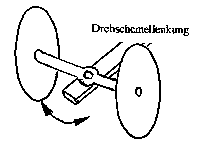 |
is known from hand-trucks. Easy to construct. The whole axle is rotated by a center of motion that is in the middle of
the axle. Disadvantage: worse tilt resistance. Potholes can take influence on the steering. A steering axle is slightly tilted towards the front will result in a tilting-effect. Axle pivot steering (“Achsschenkellenkung”):
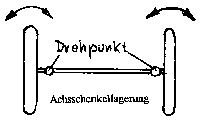 |
is known from the car. The front axle (which does not exist in a closer sense any more) is characterized as follows.
Characteristics of steered front wheels: gauge, king pin angle (inclination), axle pin rake, toe-in, roll-radius (scrub radius),... Gauge B:
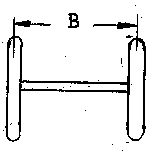 |
is the distance of the contact point between wheels and ground (more exactly: the center point of the contact surface) King pin angle S:
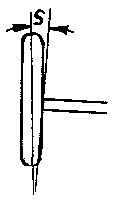 |
is the incline of the wheels to the normal of the ground. The King pin angle reduces wobbling of the wheels at high
speeds and keeps the roll radius small. Regarding HPV´s, I think a positive king pin angle is not useful because of
the rolling resistance and the wear of the tires. A negative king pin angle will probably also result in a higher rolling resistance, but reduces the stress on the wheels and reduces the tilt tendency. Axle pin rake N:
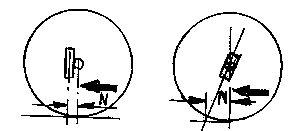 |
The turning point runs on the ground at a point in front of the contact point of the wheel. This is achieved by tilting the
rotational axis and / or by a construction where the axletree is behind the rotational axle (for example: Leitra). Toe-in X:
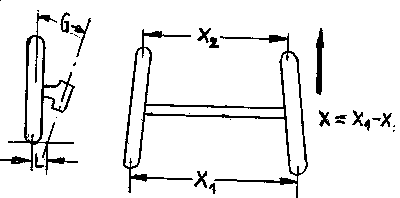 |
In most cases, the distance between the tires in the front is smaller than in the rear. This difference is called toe-in. It
compensates the destabilizing effect of the bearing clearance. Regarding HPV´s, X should be zero because of the rolling resistance and the wear of the tires. It is a good deal to measure X precisely! (The effect can depend on
fractions of millimeters!). Roll radius L: The roll radius L is the distance between the contact point of the tire and the piercing point of the rotational axis
through the ground, viewed from the front. The smaller L, the smaller is the influence of the road roughness or the tendency to brake pull to one side on the steering. Inclination of the steering knuckle pivot G:
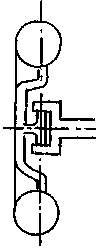 |
Is necessary to keep the roll radius small or close to zero. Therefore, he rotational axis is tilted to the inner side
referred to the wheel plane. The resulting angle is the inclination of the steering knuckle pivot. The Greenspeed has a
roll radius of zero with a inclination of the steering knuckle pivot of 14,5°.An additional effect of this inclination is, that
the weight of the vehicle takes influcence on the steering forces. Another possibility to achieve a roll radius zero is, to
move the steering knuckle to the wheel plane. This will result in positive steering properties, but requires a special hub (realised by the OLF, the "Oldenburger Leicht-Fahrzeug" of the University of Oldenburg, Germany).
Some people let the wheels asymetrically in spokes. If the wheels are set to the inner side, this reduces the stress of the spokes in curves. Steering geometry
Regarding a multitrack vehicle, the axles of all wheels should strike in one point. If this is the case in all driving conditions, this is the so-called "Ackermann"-requirement.
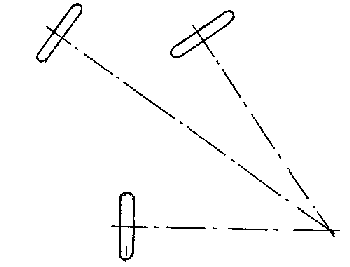 |
Even if an HPV fulfills this requirements in a state condition, this does not mean that this requirement is guilty in
running conditions. Deformation by centrifugal forces and a rough ground can take influence on the geometry, especially regarding light weighted vehicles.
One requirment for cars is the concept of a maximal normal acceleration. By this, the inner and outer wheel should
reach the limit of road grip at the same time. According to another theory, the king pin inclination should be the same
for both wheels. At utility vehicles a minimal tire wear at high deflection is achieved by a constant lateral wear loss of
the tires (a product of lateral stability and a speed component lateral to the tire). One should also note, that the
steering moment should not be negative, otherwise, the steering will catch suddenly. If the steering moment rises to
little with the deflection, the steering is somewhat "dangerous". This is not a major problem for HPV´s. Beginners often can control best tricycles with a steering that is indirect.
A single steered wheel always fulfills the Ackermann requirement. Regarding two steered wheels, the inner wheel
should deflect more. This can be achieved by a so-called "steering trapezoid", consisting out of an axle, a steering tie rod and steering arms. The steering arms are inclined to the inner side by a certain angle.
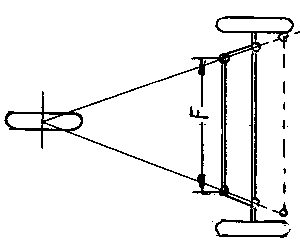 |
To determine this angle, there are several possibilities. One approximation method is done graphically. The extension
of the steering arms should strike the contact point of the third wheel. The design of tricycle steering by use of a personal computer is described by W.Möllenbruck in "Pro Velo", a
German bicycle journal (Pro Velo, Heft 28). It is in German language, and W. Möllenbruck sends the listings for this program for 10 Euro (W. Möllenbruck, Große Linsachstr. 17, 74219 Möchmühl).
This program does not only give the angle directly, but also the fraction of F:Bi. Bi is the distance of the piercing
point of the rotational axis through the ground. For my "3R4", it determined a F:Bi-ratio of 0.893.
The "Tricanter" of the University of Canterbury in New Zealand uses an axle pin rake (castor length) of 40 mm, a toe-in of 0 and a roll radius of 40 mm.
Another steering construction was chosen by Peter Ross. In his construction, the steering tie rod (not the steering arms) are tilted. A double lever A is manipulated by a handlebar under the seat.
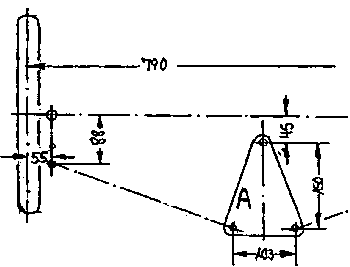 |
If one likes the construction of steering arms, a steering triangle is a good construction, as used in the Leitra.
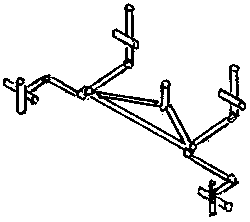 |
Another variation is used by AntroTech / Germany and Ian Sims / Australia at his tricycle "Greenspeed". The steering arms are directed to the front and the steering tie rods are crossed.
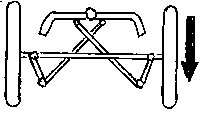 |
If the steering tie rods are canted (viewed from the top), this takes influence on the position of the wheels in case of To controll the deflection of the steering, one should do the following:
How steering constructions can be carried out:
I have seen the first three possibilities at different tricycles. The pivoting joystick steering gives a small face area. The Remarks:
Under seat steerings have to be constructed very stiff, because they are used to support the lateral movements in curves. In narrow curves at high speeds, the load displaces towards the outer wheel. This has to stand a large
amount of the total centrifugal force. This wheel runs with a large king pin inclination (the angle between the wheel
plane and the direction of motion of that wheel). In the fringe range, tadpole tricycle contructions (two front wheels) tend to understeer, delta tricycle constructions (two rear wheels) tend to oversteer.
The suspension of the wheels can be realised in the following manner:
deflection. If the steering tie rods are canted (viewed from the front), only the projections into the normal shall be used.
handlebar is easy to construct and the steering arm enable constructions with small steering forces and will result in little injury risks in case of an impact.
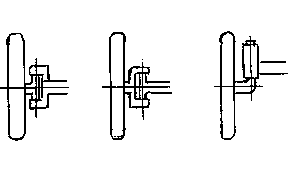 |
Elliot-type front axle (forked axle), stub axle, tower steering
The tower steering allows the use of normal bicycle head tube bearings. Because of little friction, this gives an easy-running steering. External Link: Further reading (by Peter Eland):